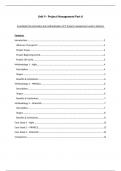Essay
Part A - Assignment 1 (Unit 9: IT Project Management) (Distinction Achieved)
- Institution
- PEARSON (PEARSON)
Distinction Achieved. This essay covers ALL LEARNING AIMS for Unit 9 - IT Project Management Assignment 1. To successfully fulfill this assignment, avoid direct replication of the provided content. Instead, draw inspiration from the structure and concepts utilized to meet the specified criteria. ...
[Show more]



